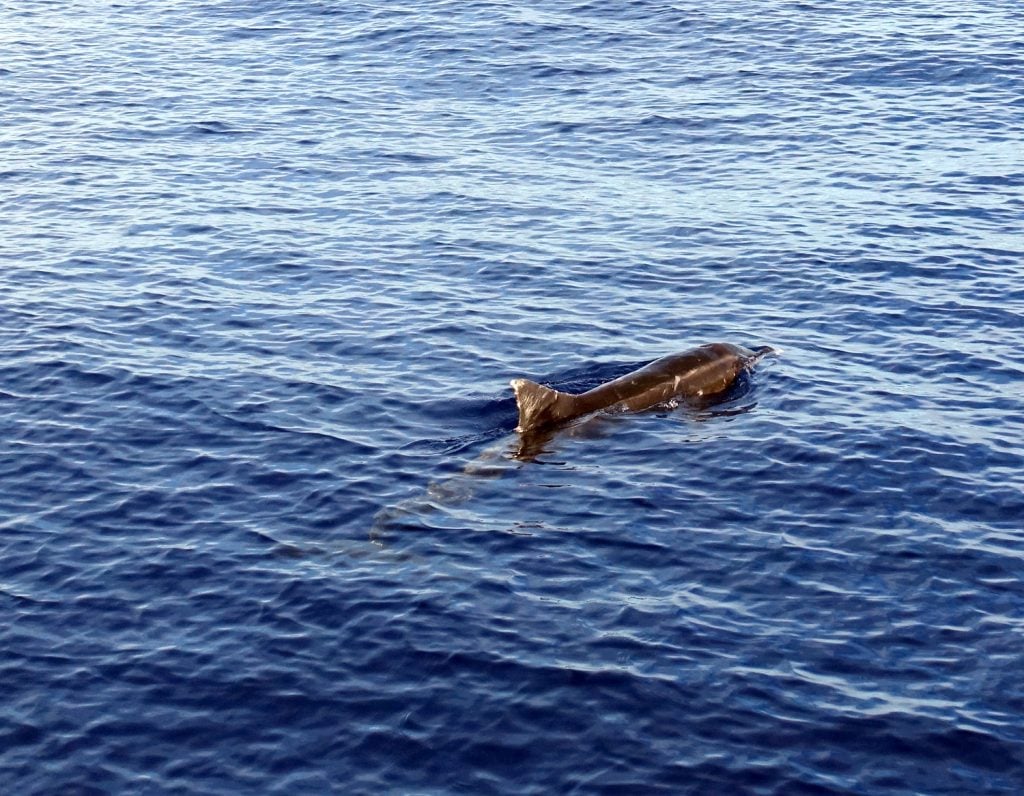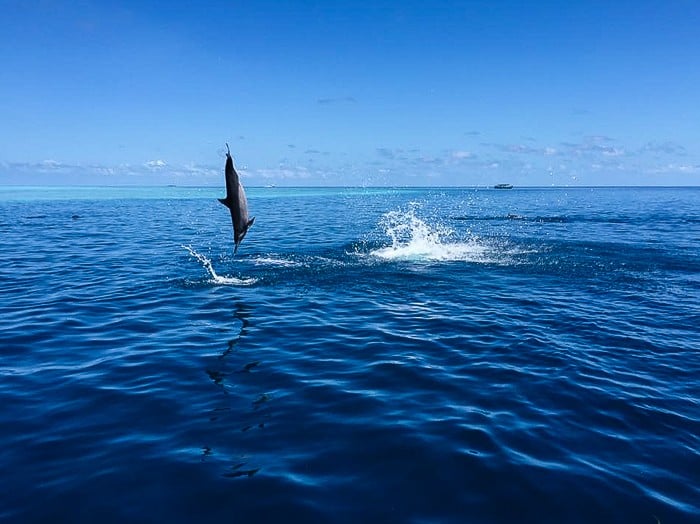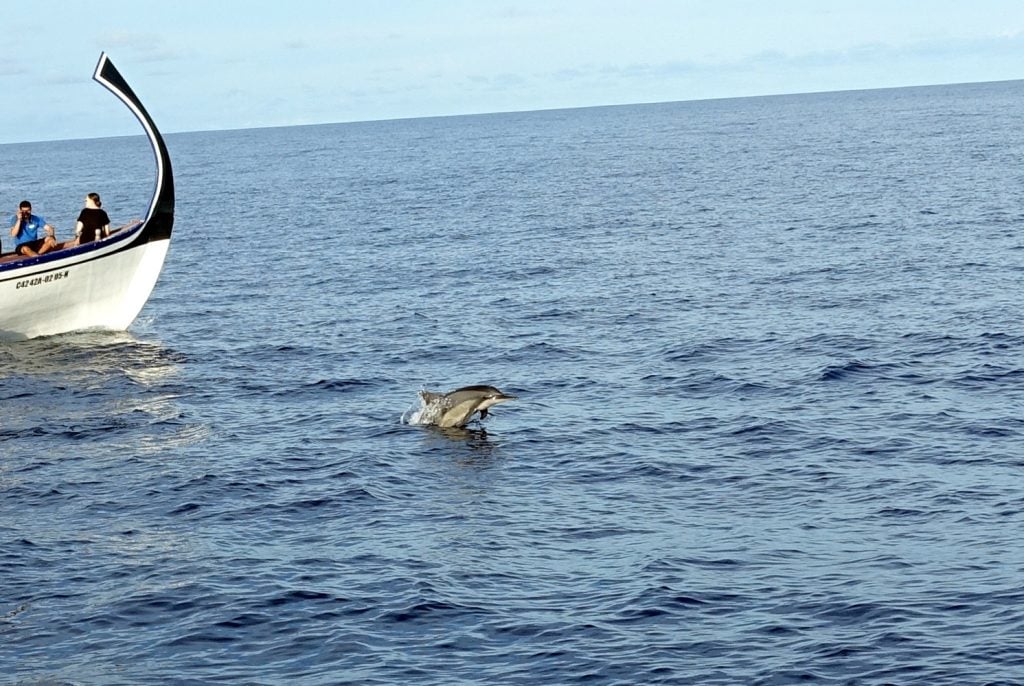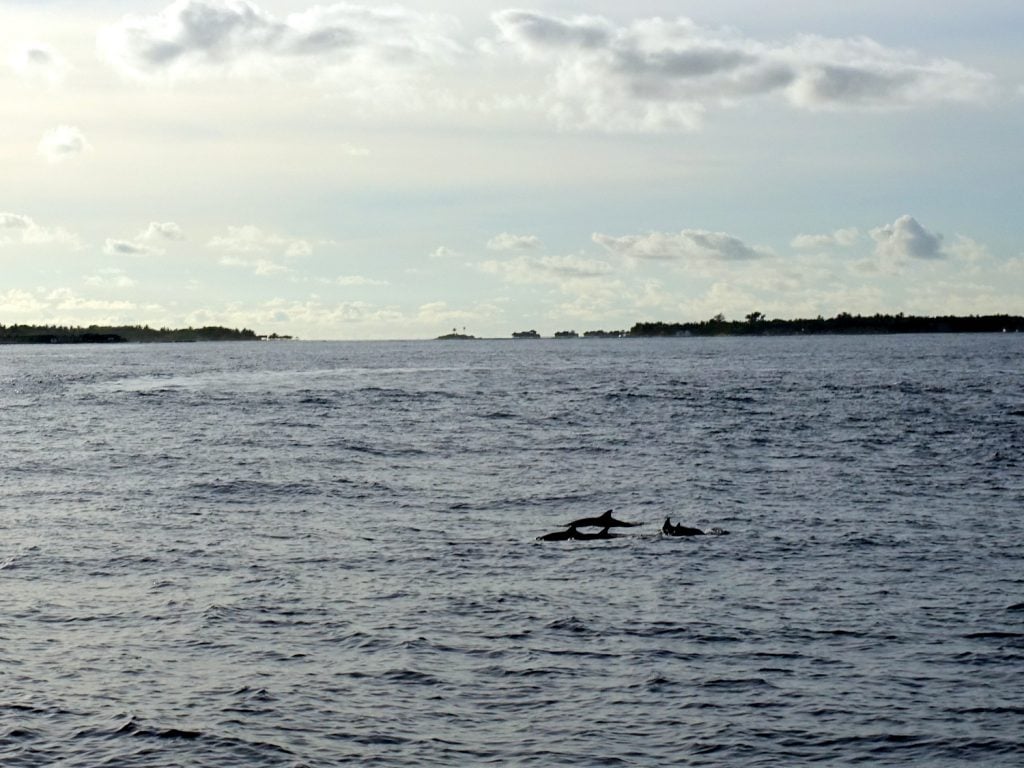The Maldives is a tourist hot spot for dolphin cruises. These majestic animals are found commonly around Gili Lankanfushi and never disappoint with their impressive aerial displays and playful attitude.

The Maldives is a dream destination for wildlife seekers and ocean adventurers. The ocean temperature averages between 27 – 31°C, contains plentiful fish and has incredible visibility. This makes it an ideal location for cetaceans: whales, dolphins and porpoises. They are aptly named as the word cetacean means huge fish.
The Maldives is home to 23 out of the 85 cetaceans species globally. The most common encounters are spinner and bottlenose dolphins. The cetacean species here are very diverse; they range in size from one metre with a weight of 50kg to 30 metres and weighing over 150,000kg. The distribution of coastal dolphins is thought to rely on a number of factors including temperature, prey concentration, location, salinity, depth, tides, habitat type, type of ocean bottom and predation pressure.
The closest living relatives to cetaceans are hippos and other hooved animals like camels and pigs. They diverged from this group over 50 million years ago. The ancestor that made the leap from land to ocean is Ambulocetus which translates to running whale for it could both walk on land and swim, although it wasn’t great at either. This mammal lived in Pakistan and was around three metres in length. Its home was the brackish waters that reside in mangrove ecosystems. Over many millions of years Ambulocetus evolved into the cetaceans that we see today. The changes include the streamlining of the body, the hind limbs regressing, a decrease in hair, increases in blubber content, expansion of the hand bones into flippers, the relocation of the nostrils to the back of the head and changes to the snout.

Bottlenose dolphins:
Bottlenose dolphins are a long lived and larger species of dolphin with a length between two to four metres. Females live around 50+ years while males reach their 40’s. On the upper body they are grey in colouration whilst the underside is paler with the belly being white. Stripes can be observed from their eyes to the blow hole, older dolphins can exhibit spotting on the underside. These dolphins live in a variety of habitats including the ocean, tidal creeks, rivers, lagoons and estuaries. Bottlenose dolphins are one of the most extensively studied species of dolphins as they inhabit inshore environments making them more accessible.
The main calving period for bottlenose dolphins is late spring/summer when the water temperature is at its peak, although they can give birth year round. These dolphins have a yearlong gestation period with an interval of three years between each birth. After birth the calves remain with their mothers for three – four years, this duration is dependent on nutrition and size. These years together are critical for development of social, foraging and courtship skills. These skills can vary greatly between habitats. Weaning of calves starts after three years and within 10 months of the mother’s next pregnancy. The age at which dolphins reach sexual maturity ranges considerably. Females are considered mature between four and 13 years and males at seven to 16 years, the difference in age is dependent on geographical and environmental differences.
Different species of bottlenose dolphins travel in different pod sizes, for example one species prefers travelling in pods between five – ten individuals whilst others in pods between 25 – 100. This variability depends upon food availability, activity, time of day and number of calves. Within these dynamic groups there may be an affinity between a few of the dolphins. These associations are hierarchical and depend on individual range and habitat type. These affinities usually occur between same sexes and mothers and calves. They have been known to last many years, with one association lasting 13 years. It has been observed that females have stronger associations and a larger social network than males.
When hunting bottlenose dolphins use the entire water column and feed on a variety of prey including fish, cephalopods, eels, small rays and sharks. Foraging methods depend on habitat, number of individuals and prey type. Dolphins are known to feed individually, in small groups and can use cooperative feeding strategies including circling, herding and bubble blowing. Dolphins are intelligent hunters, for example some have learnt to follow trawlers whilst others have been observed to use sponges on their nose for protection during hunting. These dolphins can make seasonal movements in response to prey location, water temperature and predation threats.
Bottlenose dolphins share their habitat with other dolphins including spinner dolphins. It is thought that the different species are able to live together due to differences in prey requirements and social behaviours. This co-existence is seen more commonly in the tropics and around coastal islands. This could be due to the higher concentration of nutrients compared to the open ocean.
Spinner Dolphins:
Spinner dolphins are a common species of dolphins seen in the Maldives and worldwide. They are easily identified due to their tricolor pattern, the upper side is dark grey, the middle a light grey and the underside white. They have a defined dark line from the eye to the flipper and an elongated nose. They get their name due to their unique jumping behaviour, they are the only species of cetacean to spin laterally in the air. The maximum number of spins recorded is seven. These spinning displays can vary, these variations are thought to be caused by habitat differences.

Spinner dolphins are usually found in coastal environments generally associated with island chains or atolls. Spinner dolphins have a high re-sighting rate which indicates high site fidelity. During the day they use bay areas to rest and socialise, at night they venture offshore to hunt. These resting bays are generally in close proximity to feeding grounds, have a flat and sandy bottom with a depth around 20m. These features allow the dolphins to use only vision (instead of echolocation) to keep a look out for predators. If visibility is poor the dolphins are unlikely to rest as they are vulnerable to predation.
Reproduction in spinner dolphins varies greatly between sub-species. Their calving period is year round with a gestation time of 10.5 months, after birth the calf will nurse for two years. The period between calves is three years. Females reach sexual maturity earlier than males (seven for female and seven to ten for males).

Spinner dolphins have predictable daily patterns but there social structure is variable. Group size varies with habitat, with some open ocean populations traveling in groups numbering thousands. Group size could be dependent on the size of the sandy bay bottom and activity, for example resting group size is smaller than hunting groups. Dolphins living in remote reefs and atolls have higher affinity to each other whereas coastal population are more changeable. In coastal environments individual groups rest separately during the day and can come together at night to hunt. These dolphins typically hunt prey that live in deeper water but migrate vertically at night following the plankton. Feeding occurs at depths between 200 – 400m and includes fish, shrimp and squid. The size of the prey is small (five – 15cm) with males preferring lantern fish and females cuttlefish. Spinner dolphins along with bottlenose dolphins are vulnerable to a variety of human activities and developments.
Potential Threats:
The majority of bottlenose and spinner dolphins in the Maldives reside in coastal environments which makes them highly susceptible to human activities. Coastal habitats are becoming degraded and as such management of coastal environments is critical for dolphin survival. Both species of dolphin are particularly vulnerable to human activities including dolphin watching, swimming with dolphins, pollutants including acoustic and chemical pollution, gillnets, by-catch, hunting, habitat degradation, boat traffic, sea planes, climate change, purse seines and trawling fisheries.
As awareness about the threats to the planet grows there is a shift from activities that degrade wild animal populations to activities that educate and raise awareness. The number of participants for dolphin watching activities is growing and highly profitable. Dolphin watching has many positives; less invasive than swimming with dolphins, reduced desire from aquariums, alternative employment, reduced hunting and by-catch. Unfortunately some dolphin watching activities have little or no regulations and can be conducted in a manner that is negative for the dolphins. These activities can alter feeding, resting and reproductive behaviours. Stressed behaviour can be exhibited as changes in swimming speed and direction, changes in communication, respiration rate and aerial behaviours.

It has been observed that cetaceans avoid areas with heavy boat traffic and it is thought that disturbances to dolphins could lead to increased injury rate, unsuccessful reproduction, increases stress and damages survival probability. Prolonged disturbance may lead to permanent relocation of dolphin populations. A common misconception people have with dolphins is that they can leave if they aren’t happy, dolphins can find themselves too stressed, confused and blocked in by boats to leave. Additionally, many dolphins are reliant on coastal environments, moving away from the coast can lead to diminished survival chances. As more research is conducted it has become apparent that dolphin watching can be executed in a sustainable way.
Gili Lankanfushi Dolphin Cruise:

Here at Gili Lankanfushi we operate all our activities with a sustainable focus. Including our dolphin watching trips. We have strict dolphin watching guidelines which include:
- Our boat stays 50m from dolphins
- We allow dolphins to choose to approach the boat or not
- No more than three boats within 150m of dolphins
- Boats should spend no more than 30 minutes with dolphins
- Do not approach from directly behind or head on
- No rapid changes in speed or direction
- Reduce speed when within 150m of dolphins
- Do not chase
- Take extra care around mothers and calves
- Minimize noise and vibrations
- Do not feed, touch or swim with dolphins
If you want to observe dolphins in a safe and non-invasive way be sure to join us on our 17:00pm dolphin cruise